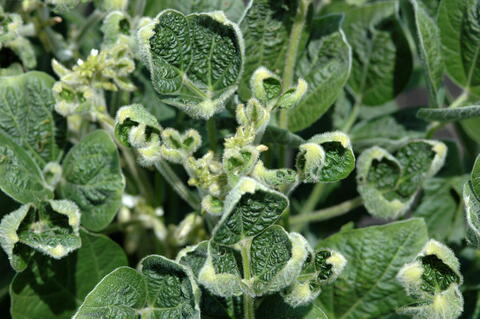2025-07-07 イリノイ大学アーバナ・シャンペーン校

Dicamba-damaged soybean leaves. Photo by Aaron Hager.
<関連情報>
- https://aces.illinois.edu/news/new-land-grant-research-detects-dicamba-damage-sky
- https://scijournals.onlinelibrary.wiley.com/doi/10.1002/ps.8954
無人航空センシングを用いたジカンバ蒸気ドリフトのシミュレーションに対するダイズ(Glycine max L.)のキャノピー応答 Soybean (Glycine max L.) canopy response to simulated dicamba vapor drift using unmanned aerial sensing
Dylan R. Kerr, Aaron G. Hager, Dylan Allen, Andrew D.B. Leakey, Dennis Bowman, Martin M. Williams II
Pest Management Science Published: 23 June 2025
DOI:https://doi.org/10.1002/ps.8954
Abstract
BACKGROUND
Concerns about off-target dicamba exposure to sensitive vegetation have escalated following the commercialization of dicamba-tolerant (DT) soybean [Glycine max (L.) Merr.] and cotton (Gossypium hirsutum L.) The spectral response of plant injury at the field scale is a crucial knowledge gap that may help researchers understand dicamba’s fate in the environment. Non-DT soybean is the ideal sentinel crop owing to its extreme sensitivity. Field experiments were conducted to characterize the reflectance spectra associated with dicamba vapor drift injured soybean canopies. The objective was, under field conditions and using land-based remote sensing, to determine what regions of the EM correlate to dicamba-injured soybean canopies.
RESULTS
Soybean injury was observed 8 days after treatment at only 1/10000th of a labeled use rate of dicamba. Correlations between simulated vapor drift and reflectance spectra at the single channel red-edge and vegetative indices excess red (ExR) and green leaf index (GLI) were observed. The study demonstrates the potential for detecting off-target dicamba vapor drift injury in soybean, with reflectance spectra following dicamba treatments observed at all spectral channels.
CONCLUSIONS
Differentiating dicamba-injured from dicamba-tolerant soybean canopies can be achieved using single spectral channels and vegetative indices. These findings usher in the possibility that remote sensing satellites, which are well-documented for identifying crop stress on the landscape, could be harnessed to understand the extent to which dicamba injury appears following over-the-top (OTT) application in DT soybean. Remote sensing technology could be instrumental in monitoring off-target herbicide injury and mitigating the effects of dicamba drift. © 2025 The Author(s). Pest Management Science published by John Wiley & Sons Ltd on behalf of Society of Chemical Industry.



